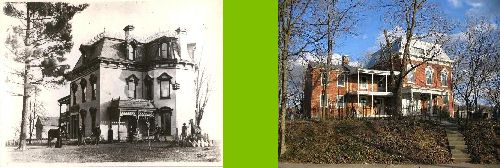
Now before you get too excited, it took about 6 hours to get this far:

It took another two hours to scrape what was left and then I got to flip over the door.

This side only has 4 layers of paint not 8 like on the reverse. If I can get the white and grey layers off then the original coats come off a lot easier. Removing the top two layers revealed the original two tone colors of this door. It also makes removing these green layers much easier.

To get this done took about 30 minutes. After 3 hours the door looks like this;

Once the paint is stripped I then use a palm sander. I start with a #60 grit paper to remove the flecks of remaining paint. I then fill the holes with wood putty before sanding with a #80 grit paper and then a #150 grit paper. Here is the door that I did last week after the #60 grit sanding;

I won't stain these doors either. I will probably use the boiled linseed oil and turpentine (or paint thinner) mix on them because the wood is quite dry and then shellac them. I expect they will turn out like this one in our bedroom;

So for all you potential strippers out there who want some advice on technique, here is what I have to offer. Not much, I know but every little bit helps. Now if you would like to slip dollar bills my way then feel free to do so! I just have to put my garter belt on....

4 comments:
ok Gary, the jig is up. Tara and I have finally solved the riddle of Dayton's famous Crack House. We've been wondering if you had 100+rooms there since it seems like for every beautiful room you've completed, you post pics of three more projects/rooms. Well, we figured it out. You're part of a government internet experiment to see how gullible renovators truly are. The Crack House is actually a movie set where interns work for free messing up rooms with terrible old paint and bad wiring. If you were truly doing all that work, with all those chemicals, wouldn't the EPA have declared Walnut Hills are Superfund Disaster Site by now? Excellent ruse with the coffee mugs by the way. It really gives the whole thing some traction.
Your reno-friends in Massachusetts
Did you end up using a liquid stripper, or just shear elbow grease? I am facing a massive stripping job, in a few days, and would benefit from any and all advice. I have used chemical strippers in the past; but, because of the size of the job I'm looking at, I'm concerned about the saftey. Nevertheless, I want to get the job done in a timely manner. I appreciate any and all help. Thanks. ---Greg
No strippers were used. If there had been shellac on the wood then I would have rubbed down the surface with steel wool and alcohol. In this case I use a palm sander.
I thoroughly enjoyed this site! I am working on restoring mahagony doors in a 75+ year old house. I have stripped them. What I can't get past is that they have either lacquer or varnish on them before they were painted. Now I am trying to sand and the sandpaper keeps getting bogged up. Please furnish me with suggestions or tips or feel free to email me at: astin@mindspring.com Many thanks!
Post a Comment